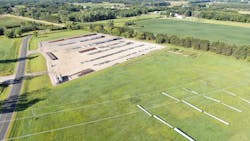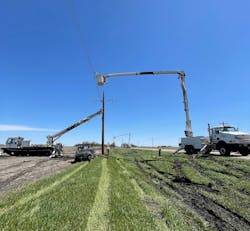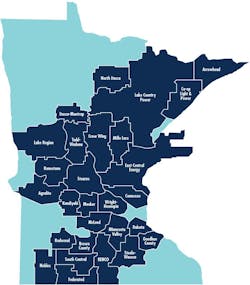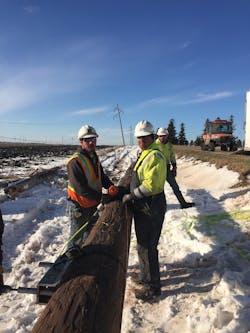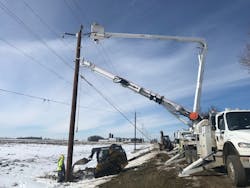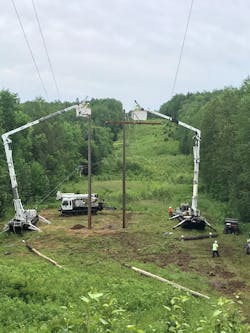Great River Energy Assesses its Resilience
Maintaining a resilient electric system has always been top of mind at Great River Energy, a generation and transmission cooperative providing wholesale electricity to 28 member-owner distribution cooperatives in Minnesota that serve two-thirds of the state. The utility’s effort to ensure system resiliency has intensified over the last several years.
While there are many threats to resilience, weather extremes that come with life in the Upper Midwest are front and center for those charged with keeping the lights on 24/7. Great River Energy’s transmission employees have several organized efforts underway — based on lessons learned from a 2019 winter storm and other self-assessments — to continually address resilience. The utility aims to be prepared for and recover as quickly as possible from major events to provide continued reliable electric service to members.
Extreme Weather Rising
Like other utilities across the U.S., Great River Energy is experiencing an increase in severe weather events that cause outages on its transmission system. The co-op owns and operates approximately 4400 miles (7081 km) of high- and medium-voltage transmission lines and more than 100 substations.
As measured by the system average interruption duration index (SAIDI), the 10 most significant outage events Great River Energy has experienced since its formation in 1999 have been caused by weather. All have occurred since 2011.
Available science suggests the extreme weather will continue, making the co-op’s focus on resilience more important than ever. Great River Energy categorizes the most significant outage events on its system as major outage events (MOEs). These events typically exceed the reasonable design limits of the electric power system and should be analyzed separately from day-to-day outages. All the utility’s MOEs have occurred during severe weather, with bow echoes, derechos and ice storms being a major risk. Prior to 2011, Great River Energy experienced one MOE every two and a half years on average. Since 2011, the utility has experienced 12 consecutive years with at least one MOE and an average of 1.7 MOEs per year. The average duration of the MOE SAIDI also has increased significantly, from 3.8 minutes prior to 2011 to 9 minutes since 2011.
“We have always been concerned with resilience, but the focus now is at a new level, based on the increased frequency with which we experience major weather events,” said Matt Lacey, director of transmission strategy and development at Great River Energy, who is the management sponsor of the transmission division’s resilience program. “Thinking about resilience into our facilities and processes has become part of our everyday work.”
Lessons From A Storm
Winter Storm Wesley, a severe blizzard and ice storm that hit the Midwest in April 2019, taught Great River Energy many things. The storm, which acted like a mini hurricane with a destructive combination of wind and ice, caused a magnitude and scope of damage the co-op had not experienced before.
As the most damaging storm in the history of the co-op, Winter Storm Wesley left Great River Energy with 355 downed poles and 15 member-owner distribution substations with extended outages greater than 24 hours. Control center employees responded to 746 phone calls and 918 radio calls during the height of the storm.
One of the biggest challenges Great River Energy faced was getting an assessment of the damage to the system.
“We could not quickly and safely get a thorough damage assessment because crews could not drive the lines; the blizzard was ongoing and roads were unsafe,” said Great River Energy’s Mark Peterson, manager, system operations. “In some instances during the blizzard, there were areas where we knew we had opportunities to isolate lines, but the weather delayed switching. We simply could not get crews where we needed to so they could open and close switches to reroute power.”
Despite these challenges, Great River Energy crews were able to set and replace all downed poles in 19 working days. That said, the co-op used the experience to learn and make improvements.
Since Winter Storm Wesley, Great River Energy has reviewed its pole specifications and inventory levels to enhance pole availability during emergency storm events. To facilitate pole inventory control as well as pole identification and delivery during major events, a centralized pole yard was constructed at the co-op’s Dickinson substation site near Buffalo in central Minnesota following a lessons-learned exercise. This centrally located facility enables engineering and purchasing staff to identify what inventory is available, so poles can be shipped quickly to where they are needed throughout the Great River Energy service territory. Great River Energy also maintains a smaller pole inventory at each of its transmission service centers — of which there are eight strategically located across Minnesota and one in North Dakota — for less impactful events that can be handled by local service center personnel.
Great River Energy’s emergency response and transmission system restoration plans also were updated. They detail the processes and procedures the co-op follows during major events. Updated annually, these plans include a detailed emergency contact list for railroads, highways and county roads. Dedicated purchasing agents and mechanical support are identified for extreme events as well as a designated point person and alternate for each functional group. Periodic scenario-based training is conducted to ensure individuals understand their roles and responsibilities and to identify annual plan changes and enhancements.
Following Winter Storm Wesley, Great River Energy performed an internal review of its design practices, including the conductor type and use of zirconium twisted-pair conductor based on geography, wind-loading design parameters and storm structure additions. The utility decided to change its design based on this review and incorporate the twisted-pair conductor more often in the southwest part of Minnesota, where galloping lines are most common for the co-op. Although it costs slightly more than traditional equipment, this conductor has an asymmetrical shape designed to shed ice and causes continuous rotation. Great River Energy expects this upfront cost will be offset by having a hardened, more resilient system that can withstand 100-year storm events.
“The twisted pair conductor is installed differently,” Peterson said. “It can be more labor intensive, and our crews will need to gain experience maintaining the line once it’s constructed. That said, ultimately, we expect the benefits to outweigh those issues. This investment where we see reliability issues due to icing will help ensure we can continue to keep the lights on for end-use members in those areas.”
Finally, Winter Storm Wesley led to the addition of automated after-hours calling software. This software enables control center operators to call out field personnel automatically, as needed. The automated callout enables system operators to focus on their core responsibilities of analyzing conditions and pinpointing issues.
Looking Inward
Great River Energy embarked on a self-review in 2021 using a transmission resilience maturity model (TRMM) designed by the North American Transmission Forum (NATF). Utilities use the TRMM to gauge their resilience readiness. It can be either administered by other NATF members or self-administered. Great River Energy self-administered the TRMM based on its familiarity with the model, having participated in other utility reviews.
According to the NATF, resilience is the ability of the transmission system and its components to minimize damage and improve recovery from nonroutine disruptions, including high-impact, low-frequency events, in a reasonable amount of time.
Conducted over two weeks, the assessment covered nine domains of resilience:
- Resiliency program management
- Risk identification, assessment and management
- Situational awareness
- Event response and recovery
- Resiliency asset management
- Information sharing and communication
- Supply chain and critical entities management
- Transportation management
- Workforce management.
The comprehensive study involved 34 employees, including many outside of the transmission division, and showed Great River Energy is strong in many areas, but there are still areas where it can improve.
In the near term, Great River Energy is focusing on risk management, situational awareness, spare equipment and ensuring its critical entities are as resilient as possible. Critical entities are those that may be critical to keep society operating, such as natural gas pumping stations powered by electricity. Other areas of opportunity include building a resilience culture, improving knowledge transfer and developing a risk register assessment tool.
“The exercise was an important step for us. It brought together people from around our company who play a role in resilience, from engineering to system operations to communications and more,” Peterson said. “We know where we can improve and what our opportunities are.”
Weather Threat Assessment
In 2021, Great River Energy had an assessment prepared to understand how a changing climate impacts the future likelihood and geographic dispersion of weather events, including ice storms, wind, ice storms with wind, tornadoes, lightning strikes and flash floods.
The assessment was used to understand how climate change could impact the future frequency and location of damage to the transmission system from these weather risks. Great River Energy has teams working on the most consequential weather threats to reliability and infrastructure. These include wildfires, summer and winter storms, lightning and flooding.
This effort will help the utility to prioritize capital spending and provide possible design standard enhancements. The co-op hopes to pursue federal funding from President Biden’s Bipartisan Infrastructure Law passed in 2021, as a portion of the bill focuses on preventing outages and enhancing the resilience of the electric grid.
“Right now, we are in the planning phase due to the lack of specificity around the program,” said Mike Saer, Great River Energy’s manager of transmission policy. “We are monitoring new funding opportunities as they are released and communicating with our member-owners.”
Paul Woodruff, portfolio project manager at Great River Energy, is leading the analytical work being done to direct future climate resilience efforts, especially around identifying which existing facilities are most susceptible to increasingly common and severe weather events. Woodruff’s focus has been on three specific weather-related areas: ice and wind, wildfires and flash flooding.
“It’s having solid operational awareness to be able to say how many of our assets are in these risk areas,” Woodruff explained. “We are working to develop GRE’s definition of acceptable risk and mitigate all assets that fall below the acceptable risk level.”
Building off the 2021 climate work, Great River Energy is studying historical weather data and maps to determine which areas of its territory are most at risk for severe weather events well into the future.
“We believe we are in a good spot,” Woodruff said. “Our current design standards are pretty robust. We’re just validating our designs and looking ahead to make sure we are designing them for tomorrow’s ice loading. As we replace older lines, we need to build them for the next 50-plus years and are starting to take that into account.”
There also is an ongoing effort to address spare equipment. Specifically, Great River Energy has established a transformer strategy team to address its spare transformer inventory. More work is being done in this area around poles and substation equipment. “Now is a great time for Great River Energy to be performing these analyses,” Woodruff noted. “As its transmission system ages and old assets are replaced with new ones, it provides an opportunity to build resilience into the designs to meet the weather of tomorrow, not just today.”
Studying Wildfire Risk
In addition to studies being done around climate change, Great River Energy also is looking at wildfire risk. Woodruff said the co-op is making sure if an asset is damaged or out of service, there is a plan in place to cover it. For example, there may be alternate sources that can serve the distribution substation. Woodruff and others also are trying to determine what Great River Energy would do if a substation was lost for a month or two. The team is determining if there are projects that could be done to help ease that burden in critical situations.
Really, Woodruff said, it is a risk-tolerance exercise of weighing the costs and benefits. “It’s a slow and steady process but we’ve got some good results so far,” Woodruff said.
Derek Howe is chief operating officer for Lake Country Power, a member-owner of Great River Energy located in a rural high-fire risk region in northern Minnesota. He said Lake Country Power has experienced fires started by trees outside a right-of-way breaking off and being blown into the utility’s lines. They caught on fire and ignited the ground below. The co-op also had downed conductors start fires in such remote areas that fire crews could only gain access by helicopter.
Great River Energy added Howe to an internal team studying the likelihood of fire events to gain insight from Howe’s experiences. The team talked about many fire-prevention options, including fire-wrapping poles, sensors to detect fire, using electronic controls to minimize energizing lines that may cause a fire and increased right-of-way clearing.
“I appreciated discussing options that Great River Energy and Lake Country Power could employ to minimize the risk of fire,” Howe said. “Hopefully my participation brought some understanding about the risk from a distribution perspective, and I was able to learn some more methods that could be utilized.”
Recent Restoration Success
Great River Energy’s increased focus on building resilience into its systems and processes paid off during a series of severe storms in May 2022. One of the three storms was the second-most damaging event in the co-op’s history, resulting in 135 damaged structures and 43 member distribution substations out of service at the worst point.
“Due to changes made in the aftermath of Winter Storm Wesley, the response to this storm was more cohesive and power was able to be restored faster,” Peterson shared.
Peterson said since Winter Storm Wesley, Great River Energy has installed additional motor-operated switches on its system, enabling system operators in the control center to remotely open and close transmission switches quickly to sectionalize damaged line sections. In May 2022, these switches were used during a storm in Great River Energy member co-op Agralite Electric Cooperative’s service area in west central Minnesota.
“Because we have motor-operated switches in this area, we were able to restore power very quickly. Agralite’s substations were restored in four minutes,” Peterson said.
In total, there are now more than 550 motor-operated switches across Great River Energy’s service territory used during storm-related restoration activity to isolate damaged line sections.
Ongoing Efforts
As Great River Energy moves forward in developing and refining its resilience strategies, the utility will continue to perform a self-review after significant storm events to identify lessons learned, evaluate leading-edge industry materials and technologies, and continue to build a culture that continuously strives to seek improvement opportunities with a focus on resilience.
“Resilience is something we want to get people to think about as part of their everyday duties,” said Mark Peterson, manager of system operations. “We want it to be part of our culture; we want people to focus on resilience.”
At Great River Energy, resilience is a journey that is never complete. The co-op will always be looking for ways to improve.
Heather Reinhart ([email protected]) is the communications specialist supporting the transmission division at Great River Energy. She has a bachelor’s degree in journalism from the University of Wisconsin-Eau Claire. After years of working in newspapers and magazines, Reinhart has spent the past five years working with Minnesota electric cooperatives, including Wright-Hennepin Cooperative Electric Association. She is a previous member of the Minnesota Rural Electric Association’s Member Service and Communications Board of Directors.
About the Author
Heather Reinhart
Heather Reinhart ([email protected]) is the communications specialist supporting the transmission division at Great River Energy. She has a bachelor’s degree in journalism from the University of Wisconsin-Eau Claire. After years of working in newspapers and magazines, Reinhart has spent the past five years working with Minnesota electric cooperatives, including Wright-Hennepin Cooperative Electric Association. She is a previous member of the Minnesota Rural Electric Association’s Member Service and Communications Board of Directors.
